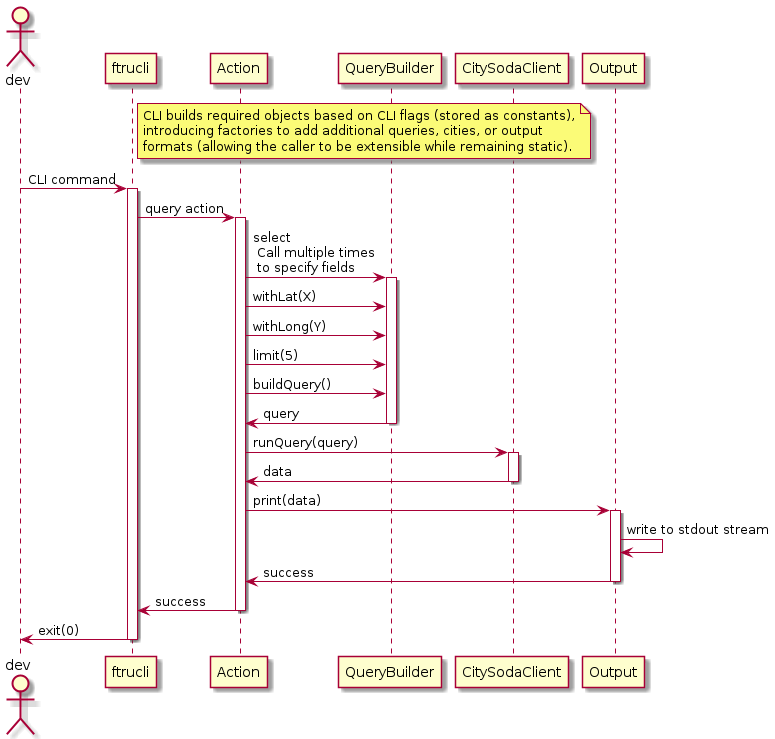ftrucli v1.1.0
ftrucli
ftrucli is a Food Truck CLI used to find food trucks near a geospatial coordinate (especially in San Francisco).
MVP Meta
This section describes the author's intent while building the minimum viable product (MVP) for ftrucli.
Foundational Intent
Above and beyond all else, the intent of this project is to...
- Demonstrate author's values
- Showcase author's problem solving process
- Curate collaboration environment (provide ideal open-source dev experience)
- Cut a release ~3 hours after
init commit
MVP Design Intent
The following areas of focus drove the design of the ftrucli MVP...
- Implement bare minimum feature set (serve at least five (5) food trucks, given a coordinate pair)
- Prioritize production readiness by focusing on...
- Organization
- Design
- Testing
- Deployment
- Documentation
- Design for extensibility
Out of Scope for MVP
Out of scope features for the MVP...
--open-now- filter for open food trucks- data caching - all queries will be against the SF SODA endpoint
- search by street address, using the Bing Maps API
- using an app token (and storing it in a
.envfile or Azure Key Vault)
Initial Design Description
The CLI will follow the basic flow of the following diagram...
 )
)
The Output class uses a factory to provide transparent extensibility for the Action component (to output results in either a prettified table or raw format).
CLI Instructions
Installation
Install the CLI globally from npm.
npm install --global ftrucliUsage
This section contains the CLI help messages and some examples.
Help Dump
General help dump...
$ ftrucli --help
usage: ftrucli [-h] [-v] <command> ...
Food Truck CLI used to find food trucks near a geospatial coordinate
(especially in San Francisco).
Positional arguments:
<command>
coord Finds food trucks within a specified distance from a
coordinate pair.
Optional arguments:
-h, --help Show this help message and exit.
-v, --verbose Print out all the debug!
For detailed help about a specific command, use: ftrucli <command> -hcoord command help dump...
$ ftrucli coord --help
usage: ftrucli coord [-h] --long LONGITUDE --lat LATITUDE [-n LIMIT]
[-d DISTANCE] [-o {prettyJson,raw,table}]
Finds food trucks within a specified distance from a coordinate pair. Filters
exist for limiting the number of food trucks which are displayed.
Optional arguments:
-h, --help Show this help message and exit.
--long LONGITUDE A user's longitude.
--lat LATITUDE A user's latitude.
-n LIMIT, --limit LIMIT
Limits the number of responses returned from a SODA
query. The default value is 6.
-d DISTANCE, --distance DISTANCE
The distance (in meters) to search outwards from a
coordinate point. The default value is 5000.
-o {prettyJson,raw,table}, --output {prettyJson,raw,table}
Determines how the results are displayed. The default
value is "table".Usage Examples
# Set long/lat, use default distance and limit
ftrucli coord --lat 37.80 --long -122.43# Specify distance
ftrucli coord --lat 37.80 --long -122.43 --distance 1000# Specify limit
ftrucli coord --lat 37.80 --long -122.43 --distance 2500 --limit 9# Use different output format
ftrucli coord --lat 37.80 --long -122.43 --output rawDevelopment
Build Toolchain Setup
This section describes how to set up the project's build toolchain. node14 (managed by nvm), pnpm, and heft are the critical tools which enable our build process. ftrucli uses build tools from the Rush Stack toolset family.
Install node14, using nvm
# Install nvm
curl -o- https://raw.githubusercontent.com/nvm-sh/nvm/v0.37.2/install.sh | bash
source ~/.bashrc
# Install node14
nvm install 14
nvm use 14Install pnpm and heft
npm install --global pnpm
pnpm install --global @rushstack/heftNOTE: Since this project uses
pnpm, please use it to install new packages (instead ofnpm). This helps maintain thepnpm-lock.yamlfile.
Install Dependencies
Use pnpm to install all project dependencies.
pnpm iBuild
This project uses heft as a build coordinator.
heft buildTest
This project uses heft as a test orchestrator (jest under the covers).
heft testLinting
This project uses eslint for linting. (TSLint is now deprecated.)
We recommend using this eslint VS Code extension.
CI/CD
This section details this project's CI and CD practices.
Continuous Integration
Continuous integration is performed on TravisCI, as defined by .travis.yml. Heft is installed, used to build the project, then used to test the project.
Continuous Deployment
Continuous deployment is out of scope, but on the roadmap.
The plan is to use GitHub actions to "watch" branches of the pattern release/*, create GitHub releases, and publish said releases to the ftrucli package repository.
Publishing
ftrucli is published on npm. This section describes best practices surrounding publishing ftrucli to its npm repository.
Versioning
Semantic versioning via using npm is standard procedure.
npm version <major|minor|patch>npm Publishing
Use npm to publish the package at the current version.
npm publishPlease create a release branch following each successful publish.
Release Branching
Release flow dictates we create a release/* branch, off of main, after each release. This is done by checking out a new branch after npm publish to "snapshot" the release version using the release/* naming convention. The wildcard, *, represents a monotonically increasing sequence of non-negative integers that is incremented on each publish.
Hotfixes are implemented in a hotfix branch and then pulled into both the current release branch and main, via PR. Old releases are treated as discardable, thus not patched.
Decision Log
| Decision | Brief Description |
|---|---|
| Rushstack used as project tool chain | Rushstack provides us with build and CLI tools. |
| TravisCI used for CI | TravisCI is this project's continuous integration tool. |